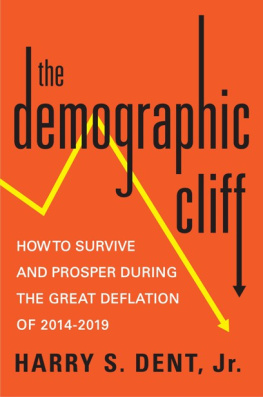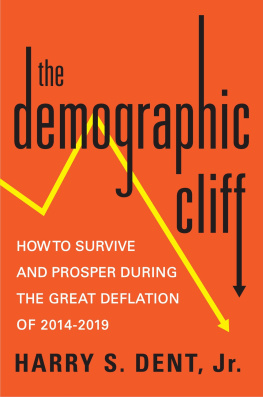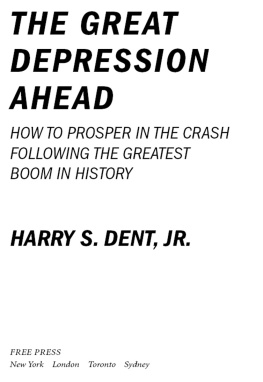Harry S. Dent Jr. - The Demographic Cliff
Here you can read online Harry S. Dent Jr. - The Demographic Cliff full text of the book (entire story) in english for free. Download pdf and epub, get meaning, cover and reviews about this ebook. year: 2014, publisher: Penguin Group US, genre: Politics. Description of the work, (preface) as well as reviews are available. Best literature library LitArk.com created for fans of good reading and offers a wide selection of genres:
Romance novel
Science fiction
Adventure
Detective
Science
History
Home and family
Prose
Art
Politics
Computer
Non-fiction
Religion
Business
Children
Humor
Choose a favorite category and find really read worthwhile books. Enjoy immersion in the world of imagination, feel the emotions of the characters or learn something new for yourself, make an fascinating discovery.
- Book:The Demographic Cliff
- Author:
- Publisher:Penguin Group US
- Genre:
- Year:2014
- Rating:5 / 5
- Favourites:Add to favourites
- Your mark:
- 100
- 1
- 2
- 3
- 4
- 5
The Demographic Cliff: summary, description and annotation
We offer to read an annotation, description, summary or preface (depends on what the author of the book "The Demographic Cliff" wrote himself). If you haven't found the necessary information about the book — write in the comments, we will try to find it.
The Demographic Cliff — read online for free the complete book (whole text) full work
Below is the text of the book, divided by pages. System saving the place of the last page read, allows you to conveniently read the book "The Demographic Cliff" online for free, without having to search again every time where you left off. Put a bookmark, and you can go to the page where you finished reading at any time.
Font size:
Interval:
Bookmark:
PORTFOLIO / PENGUIN
Published by the Penguin Group
Penguin Group (USA) LLC
375 Hudson Street
New York, New York 10014

USA | Canada | UK | Ireland | Australia | New Zealand | India | South Africa | China
penguin.com
A Penguin Random House Company
First published by Portfolio / Penguin, a member of Penguin Group (USA) LLC, 2014
Copyright 2014 by Harry S. Dent, Jr.
Penguin supports copyright. Copyright fuels creativity, encourages diverse voices, promotes free speech, and creates a vibrant culture. Thank you for buying an authorized edition of this book and for complying with copyright laws by not reproducing, scanning, or distributing any part of it in any form without permission. You are supporting writers and allowing Penguin to continue to publish books for every reader.
Illustration credits
Figures : Hoisington Investment Management Co.
Figures : Courtesy Robert Prechter, Elliott Wave International
Other graphs by the author
ISBN 978-0-698-15686-9
Version_1

COMMODITY PRICES: THE ACHILLES HEEL OF EMERGING COUNTRIES
Commodity prices affect the fastest-growing sectors of the global economyemerging countriesbut they cant be considered in isolation. So lets begin with a little context, focusing on urbanization in particular.
Developed countries are already typically 80 percent or more urbanized, but its a different story in emerging countries. Going back to the beginning of industrializationthat takes us to Great Britain in the late 1700s and early 1800swe see the beginnings of large-scale urbanization. Britain led the industrial trend, as factories required larger numbers of workers in larger cities near ports, both to receive raw materials, produce the goods, and then ship the products efficiently.
Over the last two centuries, urbanization has spread to other countries in western Europe, the United States, and finally east to Asian nations, starting with Japan, then Taiwan, South Korea, and, more recently, China. Along with industrialization came profits, and Great Britains early lead allowed it to create the greatest empire in modern times, despite working from a small island with limited natural resources (except coal, which was abundant and essential). The rest of western Europe quickly became more urban and more affluent, although early urban life was no bed of roses with sewage and air pollution rampant.
Only so many countries can dominate the highest value-added industrial products like automobiles, appliances, and computers or the new high-tech and information industries that are gaining dominance. Countries that come ). But that advantage starts to erode with higher urbanization and increased living costs, which leads to higher wages. This upward pressure on costs is the reason why industrial production has shifted more to East Asia. It also explains why Japan is a bit richer than South Korea, and China is not nearly as rich, even though it is the largest manufacturer in the world today. China produces lower-value goods like steel, clothes, shoes, and bicycles while Japan, Taiwan, and South Korea, as well as Germany and the United States, dominate higher value-added goods (like autos, higher-end appliances, and computers and components). Hence the lower standard of living in China and higher wages and comforts in Japan, Germany, and the United States. In the same way, India is not as rich as China as it is only emerging as a substantial producer of manufactured goods.
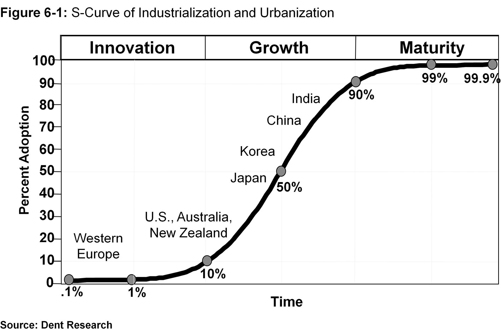
Visit bit.ly/1bcFFzg for a larger version of this graph.
But back to urbanization. When people migrate from rural areas to urban areas, their incomes tend to nearly triple, as statistics from China, India, and Brazil demonstrate. Hence, GDP growth is most affected by rising urbanization. The rates of such growth have an impact even greater than from demographic trends and, in most cases, GDP per capita rises in direct and linear relationship with urbanization.
I experienced an aha! moment a few years ago when I did some research for an interview with a Brazilian magazine. I was shocked to find that Brazil was already over 80 percent urban (see ), but still had a GDP per capita of only about $8,000 (now closer to $10,000). They were fully urban, yet had just 20 percent of the standard of living of the United States. Thats when the lightbulb lit: Brazil and most emerging countries simply wont be as rich as the Western world unless they can upgrade to higher value-added industries. And I dont see Brazil competing with South Korea in high-end industrial products because, again, there is only so much room for countries to compete in that arena.
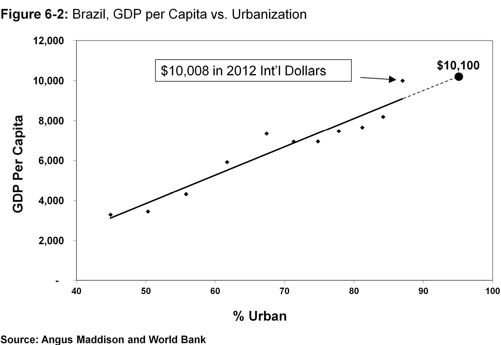
Visit bit.ly/1aDSocr for a larger version of this graph.
Only a handful of East Asian countries such as Japan, Singapore, Taiwan, and South Korea have been able to industrialize and transition from emerging countries to developed countries in the last century. Singapore did it in the information and financial sectors and, as a result, is even richer than the industrial countries (it is, after all, just one city with no rural sectors). I dont see how other candidates, such as China and India, can do the same; India is not that industrialized and, though China is, its strengths tend to be in the lower value-added sectors, which are not as profitable.
Malaysia is not quite fully urban yet is richer than Brazil and most emerging countries that dont compete in higher value-added industries. Malaysia is 73 percent urban and its GDP per capita would project to about $14,000 when it hits 80 percent urban in the next decade or so. Thats about as rich as an emerging country gets without becoming an industrial giant like Japan or South Korea.
China was the first emerging country to fully appreciate the power of three times income and GDP from moving people from rural to urban areas. It has done this faster than any major country in history, and is now 53 percent urban (see future from now will only be about $14,000, similar to Malaysiaand as good as it gets in the emerging world, falling far short of the United States and other Western countries.
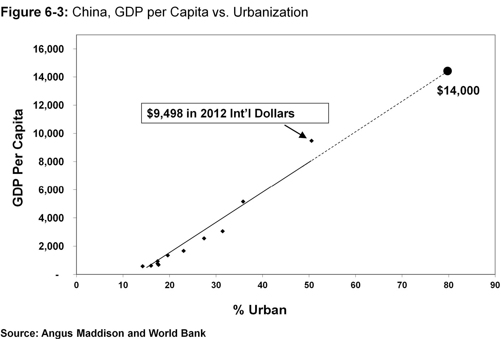
Visit bit.ly/I9fCwT for a larger version of this graph.
China now has a new up-the-ante plan for accelerating urbanization even faster, aiming to go from 53 percent to 72 percent in just twelve years by 2025. That means 250 million more people will be uprooted from their farms and moved into high-rises. However, such overinvestment by governments can only result in a bubble and a burst, as in Southeast Asia from 1997 to 2002. China has already seen the largest shift of people from rural to urban areas since 2000 with massive overinvestments in infrastructures at all levels. In addition, Chinas timing is poor, as it is upping the ante just as global growth is slowing and its own demographics are slowing. If the world were going to continue to grow and China could continue to expand exports as fast as in the past, this plan might just work. But the plan calls for the rural migrants to build the very cities and infrastructures they move into. If they discover upon completing the construction that there are no jobs in the manufacturing sector, then the relocated workers will find themselves sitting idly in high-rises; theyll be unemployed and angry. Because I see the global economy slowing dramatically in the next six to ten years, this scenario may come true, the consequence of a disastrous policy.
Font size:
Interval:
Bookmark:
Similar books «The Demographic Cliff»
Look at similar books to The Demographic Cliff. We have selected literature similar in name and meaning in the hope of providing readers with more options to find new, interesting, not yet read works.
Discussion, reviews of the book The Demographic Cliff and just readers' own opinions. Leave your comments, write what you think about the work, its meaning or the main characters. Specify what exactly you liked and what you didn't like, and why you think so.

